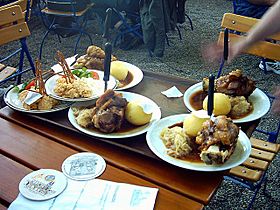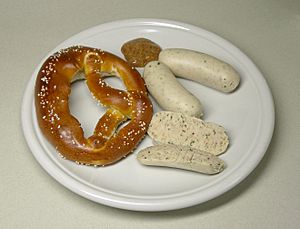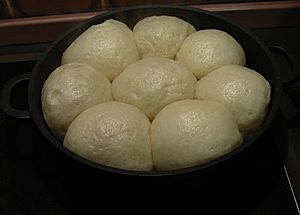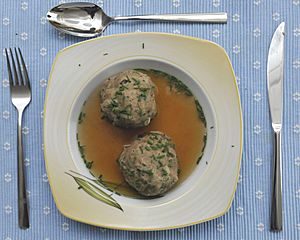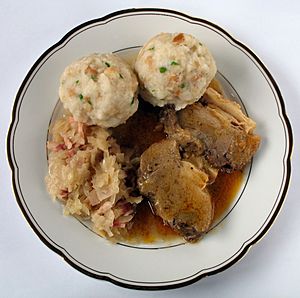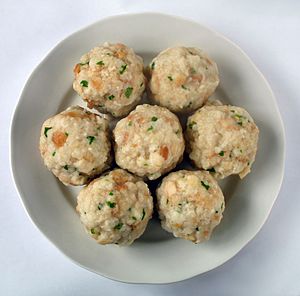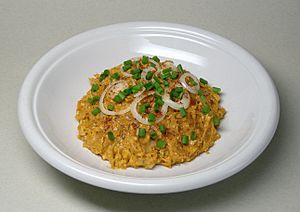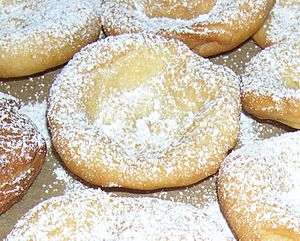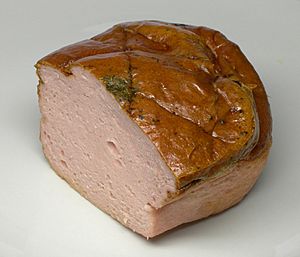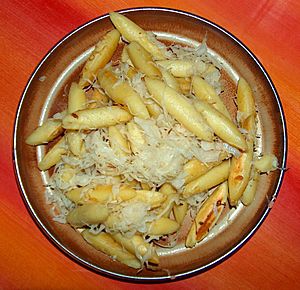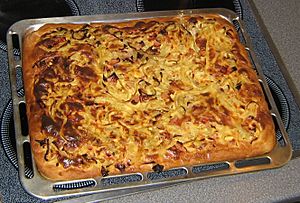Bavarian cuisine facts for kids
Bavarian cuisine is a style of cooking from Bavaria, Germany. Bavarian cuisine includes many meat and Knödel dishes, and often uses flour. Due to its rural conditions and cold climate, only crops such as beets and potatoes do well in Bavaria, being a staple in the German diet.
The Bavarian dukes, especially the Wittelsbach family, developed Bavarian cuisine and refined it to be presentable to the royal court. This cuisine has belonged to wealthy households, especially in cities, since the 19th century. The (old) Bavarian cuisine is closely connected to Czech cuisine and Austrian cuisine (especially from Tyrol and Salzburg), mainly through the families Wittelsbach and Habsburg. Already in the beginning, Bavarians were closely connected to their neighbours in Austria through linguistic, cultural and political similarities, which also reflected on the cuisine.
A characteristic Bavarian cuisine was further developed by both groups, with a distinct similarity to Franconian and Swabian cuisine. A Bavarian speciality is the Brotzeit, a savoury snack, which would originally be eaten between breakfast and lunch.
Contents
History
Cooking traditions of Bavarian cuisine date back to medieval times, where people brought different cuisines to Bavaria along with their conquerors, including Charlemagne.
Bratwurst (Nürnberger Bratwurst) was first mentioned in a document in 1313 when the council of Nuremberg described the recipe as a special product.
Beer was known to have been brewed since the Bronze Age. The ancient Germans were probably the first Europeans to have brewed beer. According to the Reinheitsgebot of 1516, introduced by Wilhelm IV, Duke of Bavaria, the only ingredients used to make beer included barley, hops and water, and including yeast. An earthenware amphora, discovered in a Celtic chieftain's burial mound in Kasendorf dates back to 800 BCE and considers to be the oldest evidence of beer-making in Europe.
There is rumour which has it that noodles were brought to Bavaria by Marco Polo, after returning from his journey in China while the Romans were gone.
The Napoleonic Wars marked the time with the occupation of Bavaria, the French influenced everything in their own way of life, mainly Haute cuisine.
Traditional dishes
Regional cuisine in the various states of the German nation has received increasing attention since the late 19th century, particularly that of the larger cities. In cookbooks of that era termed "Bavarian" both domestic rural dishes and dishes inspired by French cuisine were published. The cookbooks concentrated on dishes based on flour and Knödel. For the regular people, even the people living in cities, meat was usually only reserved for Sundays.
The 19th century cookbooks included many recipes for soups containing Knödel. The meat recipes were mostly based on beef and veal, where cooked beef was used for everyday meals. In the case of pork, suckling pig played a great role. "The use of offal and the entire slaughtered animal - especially the calf - from head to toe was a special characteristic of the recipes collected in the Bavarian cookbooks. Udders, tripe, calf head, calf hoofs, etc. have changed from 'poor man's dishes' [...] to the prestigious 'Schmankerl' of the new Bavarian regional cuisine. [...] The prominence of head cheese, prepared both sweet and sour, seems to also be a speciality of Bavarian cuisine."
Knödel and noodles were a traditional festive dish in Bavaria. In the late 19th century, chopped pork with Knödel was a typical Bavarian regional dish. The Munich Weißwurst was "invented" only in 1857. There were few recipes for mixed vegetables in the cookbooks, and stews played hardly any role, but the Pichelsteiner stew is said to be introduced in Eastern Bavaria in 1847. In the 19th century, the vegetables that most of the Bavarians usually ate were Sauerkraut and beets. French-influenced dishes included Ragouts, Fricassee and "Böfflamott" (Boeuf à la Mode), larded and marinated beef. This was mostly only reserved for the nobility, but was later also adopted into the cuisine of ordinary people.
A report from 1860 says: "A characteristic of the nurture of the Upper Bavarian rural people is the overall prominence of flour, milk and lard dishes with vegetables added and the diminished consumption of meat dishes on the five most important festive days of the year: Carnival, Easter, Pentecost, Kermesse and Christmas [...]".
Munich cuisine
The everyday cuisine of the citizens of the state capital Munich differed somewhat from that of the rural people, especially by the greater consumption of meat. In the city, more people could afford beef, and on festival days, roast veal was preferred. From 1840 to 1841, with Munich having a population of about 83,000 citizens, a total of 76,979 calves were slaughtered, statistically approximately one calf per citizen. The number of slaughtered cows was about 20,000. Bratwursts of beef were especially popular. In the 19th century, potatoes were also accepted as part of Bavarian cuisine, but they could still not replace the popularity of Dampfnudel.
A main reason for the preference for veal in Munich was the striking lack of space in town, allowing for smaller animals only. With its preserved, near-medieval grid of narrow lanes and streets and similarly narrow, half-gabled houses, including run-through staircases without landings called Himmelsleiter (Jacob's ladder), most people could only afford to keep two pieces or so of small framed livestock in ground floor crates at the rear ends of their houses. Calves reaching heifer size, nearing maturity, would consequently either have had to be slaughtered or to be sold out of town.
The typical meat-oriented Munich cuisine was not always accepted by others. One author wrote about Munich in a 1907 publication: "The 'Munich cuisine' is based on the main concept of the 'eternal calf'. In no other city in the world is so much veal consumed as in Munich … Even breakfast consists mainly of veal in all possible forms … mostly sausages and calf viscus! … The dinner and evening meal consist only of all sorts of veal … And still the Munich innkeepers speak of a 'substantial selection of dishes' without realising that the one-sidedness of the 'Munich veal cuisine' cannot be surpassed any more!"
List of dishes
Appetisers
Soups
- Bread soup
- Chanterelle soup with Semmelknödel
- Eintopf
- Griessnockerlsuppe (Semolina Dumplings Soup)
- Semolina Knödel soup
- Hochzeitssuppe
- Leberknödelsuppe Liver dumpling soup
- Liver Spätzle soup
- Pancake soup
- Sauerne Suppn ("sour soup", a soup made of hardened milk)
- Bacon Knödel soup
Main courses
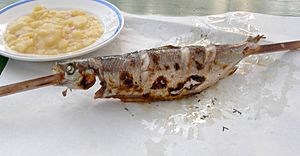
- Saures Lüngerl
- Roast pork with potato Knödel or Semmelknödel
- Surbraten, roasted cured pork or Haxe
- Krustenbraten
- Tellerfleisch
- Schweinsbraten – A traditional Bavarian roast pork dish that is common in upper Bavaria
- Schweinshaxe
- Sauerbraten
- Skirt steak
- Pichelsteiner
- Kalbsvögerl
- Kesselfleisch
- Reiberdatschi
- Fingernudeln
- Schupfnudeln
- Schmalznudeln
- Rohrnudeln
- Schuxen
- Bröselschmarrn
- Fleischpflanzerl
- Cabbage rolls
- Suckling pig
- Bröselbart
- Gnocchi
- Käsespätzle
Snacks
Delicacies
- Apfelkücherl
- Bratapfel
- Dampfnudel
- Kaiserschmarrn
- Germknödel
- Magenbrot
- Garrapinyades
Desserts
- Apfelstrudel
- Bavarian cream
- Baumkuchen
- Coffee and cake (kaffee und kuchen)
- Dampfnudeln – a steamed dumpling with a sweet fruit sauce
- French toast (Armer Ritter; [lit.] "Poor Knight")
- Bienenstich
- Gugelhupf
- Schwarzwälder Kirschtorte
- Prinzregententorte
- Topfenstrudel
- Milchrahmstrudel (Millirahmstrudel)
- Zwetschgendatschi
Sausages and meat dishes
Most Bavarian sausages are produced using pork.
- Head cheese
- Weißwurst with sweet mustard
- Black pudding
- Bierwurst
- Gelbwurst
- Milzwurst
- Wollwurst
- Stockwurst
- Regensburger Wurst
- Leberkäse
- Wiener Würstchen
Salads
- Bavarian potato salad
- Potato and cucumber salad
- Bavarian Wurstsalat
- Coleslaw
- Sour Knödel
Specialties
Bavaria
- Allerseelenzopf
- Auszogne
- Bayrisch Kraut
- Red cabbage
- Bavarian blue cheese
- Bauernseufzer
- Pretzels
- Böfflamott ("Boeuf à la mode")
- Kartoffelkäse
- Hopfenspargel
- Fried dough foods
- Horseradish
- Leberkäse
- Munich onion meat
- Sauerkraut
- Obatzda
- Asparagus
- Gwixte
- Head cheese
- Raphanus
- Black-smoked ham
- Steckerlfisch
- Weisswurst
Bavarian Swabia
- Brenntar
- Cheese spätzle
- Onion bratwurst
- Bergkäse
- Schupfnudel
Franconia
- Nuremberg bratwurst
- Nuremberg lebkuchen
- Franconian zwiebelkuchen
- Franconian wood oven bread
- Fruitcake
- Schlachtschüssel
- Saure Zipfel
- Schneeballen
- Schäufele
Drinks
- Wheat beer
- Pale lager
- Radler
- Märzen
- Bock
- Spezi
- Shandy
- Bärwurzschnaps
- Blutwurzschnaps
- Enzianschnaps
- Obstler
- Franconian wine
Yiddish Bavarian cuisine
There is also a subdivision of Bavarian cuisine, named Yiddish Bavarian cuisine, which includes dishes like:
See also
 In Spanish: Gastronomía de Baviera para niños
In Spanish: Gastronomía de Baviera para niños


